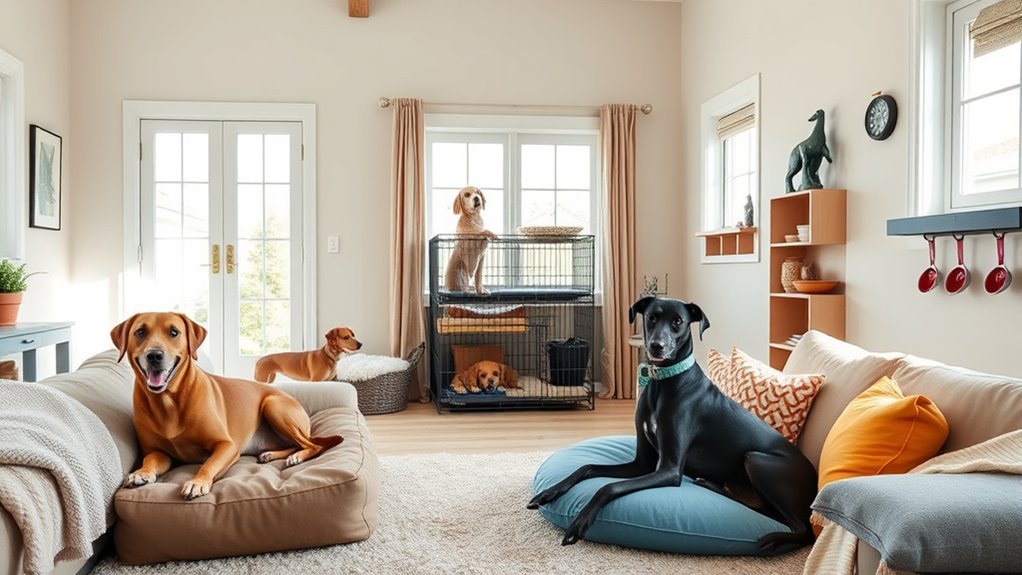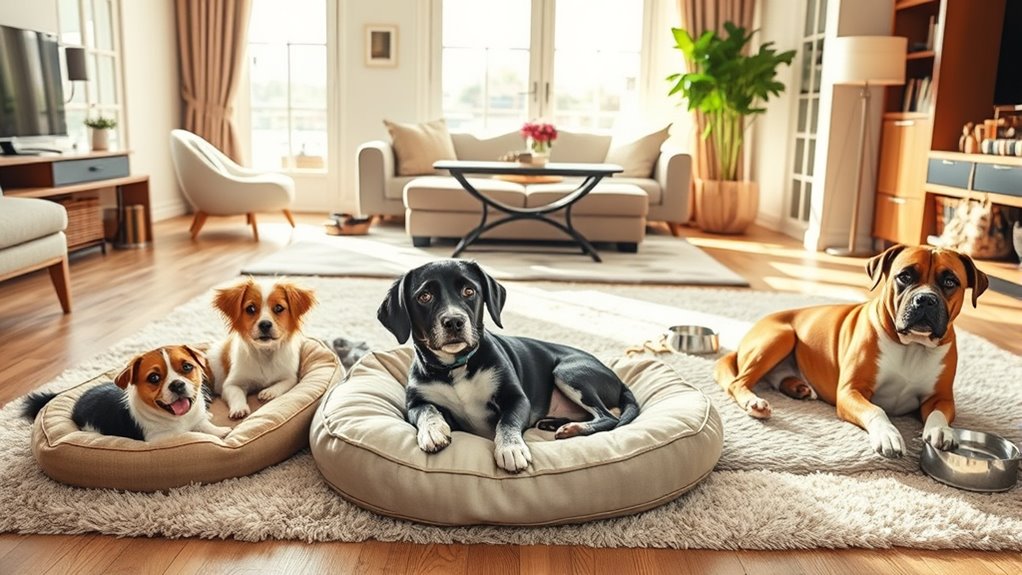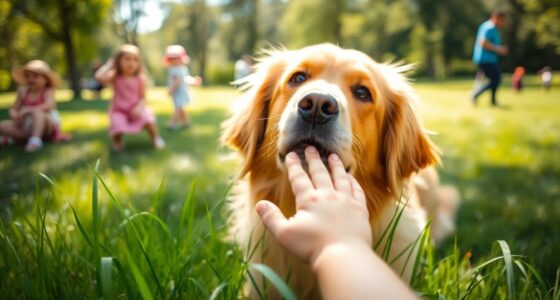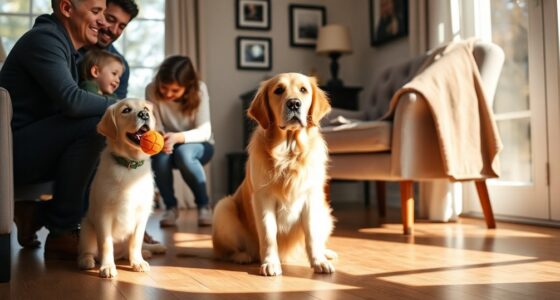To manage multiple dogs at home, establish consistent routines for feeding, grooming, and playtime tailored to each dog’s needs. Feed them in separate areas to prevent conflicts, and guarantee grooming sessions are calm and organized. Create a peaceful environment by balancing attention and fostering positive behaviors. Patience and organization are key to maintaining harmony. Keep routines flexible and attentive, and you’ll discover effective strategies to keep all your dogs happy and well-adjusted.
Key Takeaways
- Establish separate feeding areas and routines to prevent food conflicts and promote peaceful meal times.
- Create consistent grooming schedules tailored to each dog’s breed and needs to reduce stress.
- Designate individual spaces or crates for each dog to prevent territorial disputes.
- Maintain a structured daily routine for feeding, grooming, and exercise to foster stability and reduce anxiety.
- Monitor and address behavioral issues early, ensuring each dog receives individual attention and care.

Managing multiple dogs in one home can be challenging, but with proper planning and consistency, it’s entirely achievable. One of the key aspects is making certain each dog’s needs are met, especially when it comes to their dog diet and grooming routines. Your goal is to create a balanced environment where all your dogs feel secure and cared for, which starts with feeding habits. To manage their dog diet effectively, you should establish a feeding schedule that suits each dog’s age, size, and health needs. This prevents food aggression and competition at mealtimes, reducing stress for everyone. Measure out portions carefully and select high-quality, appropriate food for each dog. This way, you avoid overfeeding or underfeeding, which can lead to health issues. Keep in mind that some dogs may have special dietary requirements, so consult your veterinarian if needed. It’s also wise to feed your dogs in separate areas or crates to prevent conflicts and make sure each eats peacefully. Incorporating consistent routines can also help reinforce positive behaviors and reduce anxiety among your pets.
Grooming routines are another essential element to manage when you’re caring for multiple dogs. Regular grooming not only keeps your dogs looking their best but also helps prevent health problems like skin infections or matting. Establish a consistent grooming schedule tailored to each dog’s breed and coat type. For example, some dogs may need daily brushing, while others only require weekly baths. Designate specific grooming areas that are calm and free of distractions, making the process less stressful for your dogs. Using the same tools and routines can help your dogs feel comfortable and secure during grooming sessions. Also, check their ears, teeth, and nails regularly as part of your grooming routine to catch potential issues early. When managing multiple dogs, it’s important to keep these routines consistent so they know what to expect and don’t become anxious or resistant.
Balancing these routines requires organization and patience. You might find it helpful to create a schedule or checklist for feeding and grooming to stay on track. This ensures each dog receives individual attention and care, which is fundamental for their well-being. Remember, managing multiple dogs is about creating harmony, so be patient and adaptable as you fine-tune your routines. By prioritizing proper dog diet and grooming routines, you set the foundation for a peaceful, healthy household where everyone’s needs are met. With time, your dogs will thrive in their shared environment, and you’ll enjoy the rewards of a well-managed multi-dog household.
Frequently Asked Questions
How Do I Introduce New Dogs to My Existing Pets?
When introducing new dogs, start with supervised meetings in neutral territory to respect theDog pack hierarchy. Use socialization techniques like calm, positive reinforcement to build trust. Allow the dogs to observe each other from a safe distance, then gradually increase interactions. Keep initial meetings brief, and watch for signs of stress or aggression. Consistent, patient introductions help your pets adjust smoothly and foster a harmonious multi-dog household.
What Are Signs of Dog Jealousy or Aggression?
You’ll notice signs of dog jealousy or aggression through their body language, like stiff posture, growling, or direct stare. Jealousy cues include pushing or guarding resources, such as toys or food. If your dog snaps, lunges, or shows excessive barking when another dog is near, these are clear signals of jealousy or aggression. Address these cues early with calm redirection and positive reinforcement to keep harmony in your home.
How Can I Prevent Resource Guarding Among My Dogs?
In the days of yore, you’d guarantee harmony among your dogs. To prevent resource guarding now, focus on consistent dog feeding routines and designate separate eating areas. Practice toy management by rotating toys and offering individual playtimes, so no dog feels threatened. Reward sharing and calm behavior, reinforcing positive interactions. These steps help foster trust and reduce competition, making your home peaceful and enjoyable for all your furry friends.
What Should I Do if My Dogs Fight?
If your dogs fight, quickly intervene to separate them safely, using a loud noise or a barrier to avoid getting hurt. Stay calm, avoid punishing them, and assess the situation afterward. You should also seek behavioral intervention from a professional to understand the root cause of the dog conflict and develop strategies to prevent future altercations. Consistent training and supervision are key to maintaining harmony.
How Do I Handle Different Exercise Needs for Multiple Dogs?
Did you know that dogs with diverse exercise needs are more prone to stress and behavioral issues? To handle different exercise needs, tailor your approach with separate walks or play sessions to make certain each dog gets adequate activity. Incorporate dog socialization and training routines into daily life, making sure each dog’s energy level and temperament are considered. This keeps everyone happy, balanced, and healthy while strengthening your bond.
Conclusion
Managing multiple dogs is like orchestrating a lively symphony—you need patience, consistency, and a little bit of humor. By setting clear boundaries, providing individual attention, and fostering positive relationships, you’ll create a harmonious home where your furry friends thrive together. Remember, each dog is a unique instrument, and with love and care, your household can become a beautiful melody that brings joy to everyone involved. Keep at it, and the harmony will follow.









